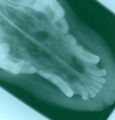Caused by Aspergillus spp.
- Avians:
- Diffuse infection of the air sacs
- Diffuse pneumonic form
- Nodular form involving the lungs
- Spores are inhaled
- Yellow nodules in the lungs and air sacs
- The acute form usually affects young birds and is rapidly fatal (within 24-48 hours)
- Signs include diarrhoea, listlessness, pyrexia, loss of appetite and loss of condition
- Sometimes convulsions may occur
- Resembles Pullorum disease
- The chronic form usually occurs in adult birds and is sporadic, presenting with milder clinical signs
- Cattle:
- Infection can cause abortion and ocular infections
- Infections involve the uterus, fetal membranes and fetal skin
- Lesions are usually up to 2mm in diameter and contain asteroid bodies with a germinated spore in the centre
- Acute infection causes miliary lesions
- Chronic infections causes granulomatous and calcified lesions
- Horses:
- Guttural pouch mycosis common
- Infection can cause abortion
- May cause COPD
- Dogs, cats and sheep:
- Infections occur, but infrequently
- lungs and nasal cavity most usually affected
- Disseminated form with granulomas and infarcts can occur in dogs
- Pulmonary and intersitital forms can occur in cats
- Humans:
- Primary and secondary infections
- lungs, skin, nasal sinuses, external ear, bronchi, bones and meninges all affected
- Infection occurs most frequently in immunocompromised patients
- Grows on Sabauraud's Dextrose and Blood agar
- White colonies intitially which turn green, then dark green, flat and velvety
- Colony colour varies with species
- Also grows on Czapek-Dox agar and 2% malt extract agar supplemented with antibacterial antibiotics
- Microscopically:
- Conidiophores with large terminal vesicles (only visible in the lungs and air sacs where there is access to oxygen)
- Vesicle shape varies depending on the species
- Is a common contaminant so repeated tests should be done for a definitive diagnosis
- Conidiophores with large terminal vesicles (only visible in the lungs and air sacs where there is access to oxygen)
- Serology:
- Gel immunodiffusion for canine nasal asper
- Treatment:
- Surgery
- Antifungal drugs
- Pathology:
- Aspergillus fumigatus causes rhinitis, respiratory tract inflammation and sinusitis
- Sometimes appears on lesions of ethmoidal haematoma
Aspergillus fumigatus
- Aspergillus fumigatus
- Most commonly in dogs but also other species
- Causes rhinitis, often also involves the frontal sinus
- Chronic necrotising inflammation with friable exudate containing necrotic tissue and fungal hyphae
- Result in severe neutrophilic rhinitis/sinusitis
- These lesions can be aggressive causing destruction of turbinates and nasal septum
- Can occur secondary to areas of mucosal compromise eg: adjacent to a space-occupying lesion
- Can cause pulmonary aspergillosis especially in birds, but also other animals
- Initiated by inhalation of spores,the most likely source of which is mouldy feed and bedding
- Given the wide exposure that occurs, it is thought that immunodeficiency may contribute to colonisation with this organism
- Gross lesions :
- Multiple discrete grey/ white nodules which develop around fungal colonies
- Blood vessels can become involved in the lesions -> invasion, haemorrhage or thrombosis
- Histologically:
- Granulomatous chronic lesions
- Macrophages and epithelioid cells
- Fibrous capsule
- In horses:
- Nasal aspergillosis
- Guttural pouch infections in horses - fungal plaques form on the adventitia of the carotid arteries can lead to catastrophic haemorrhage following erosion of carotid arteries!
- Often present with epistaxis
- May present with neurological dysfunction
- Rarely extends to other resions: cranium, middle ear, atlanto-occipital joint
- May extend to sinuses










